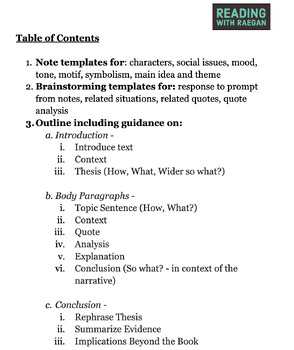Complete Literary Analysis Note Taking and Essay Outlining (Works for Any Book)
- Google Docs™

Description
Are you looking for ways to help students organize their thinking surrounding their reading and then to translate that thinking into an analytical essay? This template will help with all of the steps from note taking to brainstorming to outlining. We suggest teaching each part of the template separately using a different text, but you know your students best!
This template includes:
1. Character Analysis Note Guidance: traits, motivations, interactions + prompts to include supporting evidence
2. Social Issues Note Guidance: defined as- a problem that affects many people within a society (i.e. racism, sexism, gender roles, homelessness, climate change etc)
3. Mood Note Guidance: defined as - As a literary device, mood refers to the emotional response that the writer wishes to evoke in the reader through a story.
4. Tone Note Guidance: defined as - Tone is a literary device that reflects the writer’s attitude toward the subject matter or audience of a literary work. This literary device may also strictly apply to convey the attitudes and feelings of a certain character or narrator.
5. Motif Note Guidance: defined as- Motif is an idea that repeats itself throughout a literary work. It often supports the theme or establishes a mood.
6. Symbolism Note Guidance: defined as - Objects or ideas that have both literal and figurative meanings. It could appear once or many times in a text.
7. Main Idea Note Guidance: defined as- A 1 sentence summary of the text that a writer intends to convey to the audience. (Specific to the narrative of the story)
8. Theme Note Guidance: defined as - A theme is a universal idea, lesson, or message explored throughout a work of literature. One key characteristic of literary themes is their universality. Themes are ideas that not only apply to the specific characters and events of a book or play, but also express broader truths about human experience that readers can apply to their own lives. It is not a 1-3 word topic (i.e. friendship), but a sentence (i.e. Friendship can be found in strangers.)
9. Brainstorming Guidance: Pull from notes above, find quotes that align, analyze quotes.
10. Outline:
Introduction -
Introduce text
Context
Thesis (How, What, Wider so what?)
Body Paragraphs -
Topic Sentence (How, What?)
Context
Quote
Analysis
Explanation
Conclusion (So what? - in context of the narrative)
Conclusion -
Rephrase Thesis
Summarize Evidence
Implications Beyond the Book





